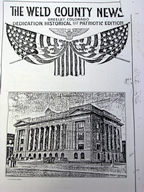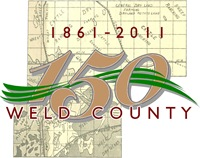Home
Courts
By District
19th Judicial District
Court House Architecture
| Court House Architecture |
W.N. Bowman Creation The Weld County Court House is an exceptional illustration of the Beaux-Arts style of architecture. A neo-classical style of architecture, this style was used extensively between 1880 and 1920 especially for public buildings and other structures that required imposing yet dignified facades.
It was designed by W.N. Bowman, a renowned architect in the Denver area, who built many other public buildings along the Front Range in Colorado and in Wyoming. General contractors Seerie & Varnum completed the structure after two years in 1917 at a total cost of $414,302.05 which included the cost of furnishings.
The Court House is primarily constructed of Indiana limestone and terra cotta. Large blocks of granite set on concrete footings were used in the construction of the foundation. Steel trusses form the roof support, and riveted steel girders form each floor. Interior load-bearing walls are constructed of hard-burned brick with partitions of gypsum tile laid to form walls four inches thick.
Intricately detailed bronze doors welcome visitors at all entrances. Doors, railings and light fixtures throughout the building are made of solid brass or bronze. Very little wood was used in the construction of the court house, except for hand railings and furnishings in the court rooms.
There are very few photographs of how the interior of the Court House looked when it was first opened to the public in 1917. Through its many renovations over the years, the interior has changed from gun metal gray during the WPA in 1935 to its current accents of bright blue and gold and other bright colors which accent the symbolic and mythological reliefs that decorate each floor.
First Floor
The First Floor features handcrafted black and white tile floors with equilateral cross designs that border the original walls. The Swastika or “crooked cross” dates back to the Neolithic period. Examples of its use even date back as far as 4000 BC. It was used by many ancient cultures throughout the world including Native American tribes in the Americas. The design faded from historical records until its resurgence in the late 19th Century after the discovery of ancient Troy by Heinrich Schliemann. By the early 20th Century, it was used worldwide as a symbol of good luck and success. Architects quickly adopted the symbol for decorating public buildings. Unfortunately the symbol became identified with Nazi Germany which adopted the cross as its party flag in 1920.
Just inside the north and south doors of the Court House are bright colored hand crafted mosaics of the State seal.
Second Floor
The second floor was designed specifically for county government offices including the Office of the County Commissioners and County Treasurer. Symbols of government such as the Eagle and Coat of Arms adorn the walls.
The Second Floor displays beautiful craftsmanship in carved marble and molded plaster work. The Balustrade above the entrance and carvings along the walls are characteristic of the Beaux-Arts style and neo-classical architecture. Isolated medallions or Rondelles and frieze reliefs decorate both walls along the stair case inside the east entrance. The second floor ceilings are lavishly decorated as are the columns surrounding the Atrium.
Beyond the grand staircase are the original stained glass windows created by a Swiss artisan whose name has been lost to history. These windows, along with those on the upper level were renovated and reinforced through a grant provided by the Colorado Historical Society in the 1990s.
Third Floor
The third floor was home to the original county and district court courtrooms, chambers, and the clerk’s offices. The offices of the County Superintendent of Schools and County Surveyor also resided on this floor. The hallway contains some of the most beautiful decoration in the entire building. Hand carved plasterwork on the ceiling is replete with swagging, fruits, scrollwork and other lavish ornamentation. The Festoons contain three dimensional images that may represent labor or harvest and lavish drapery more associated with the classical Baroque style.
The original District Court courtroom now known as Division 3 is a treasure chest of beauty and craftsmanship. No documentation exists as to why Mr. Bowman chose the symbols he used to decorate the courtroom, but it is believed the cornice above the courtroom entrance shows the Torch of Liberty, the Book of Laws, and the Shell of Saint James. It is also believed the design created around the clock on the back wall of the courtroom is symbolic of justice and that the clock itself depicts time spent in settling matters of law.
On the south end of the third floor is a beautiful illustration of a barrel-vaulted ceiling. Engaged columns and arcades line the walls.
The landing between the third and fourth floors contains another collage of stained glass windows. The design contains the inscription “NIL SINE NUMINE” which generally means “nothing without divine will.” This inscription is also the motto for the State of Colorado. It should be noted that in Colorado the district court is the highest trial tribunal of the state trial courts.
Fourth Floor
The fourth floor of the Court House originally housed jury rooms, the meeting room for Grand Jury, the Court Reporter’s office, and the Law Library. At the north end of the hall were sleeping quarters for jurors, one for women and one for men. Each of the sleeping rooms contained six beds and wash stations for jurors who would be sequestered during trial.
The Division 1 courtroom was a relief courtroom used for induction ceremonies, immigration and naturalization swearing-in ceremonies, deportation hearings, and would be used in the event both district and county courtrooms were busy. This courtroom in particular has puzzled visitors and workers alike with the variety of mystical and mythological ornamentation contained within its walls. Inside the entryway and above the door is a symbolic image of the Goddess of Justice. She takes a special place of honor overlooking the judgments handed down by the court. On top of the marble bench is a large globe encircled by smaller globes. It is believed this globe symbolizes the principles of universal law.
Stunning in their beauty are the two hawk-like creatures that surround the clock at the back of the courtroom. These two creatures are mythological creatures called Harpies who were known for their cruelty. In Greek mythology they were known for stealing food from Phineas, a king of Thrace. Although it is only speculation, the presence of these creatures in the courtroom may represent the evils of man, and the belts around their waists may be symbolic of the law bringing evil to justice. In other words, the courts can be seen as arenas where battles rage between good and evil and where justice prevails in the end.
Room 410 is an auxiliary room now used for meetings. It houses a pictorial history of the judges who served Weld County since its formation. The room also contains a very large replica of the Colorado State Seal made exclusively from tools and other hardware items donated by a local hardware store. The replica was presented to the Court House by the Colorado President of the Hardware Association in the 1960s.
The Law Library that was housed on the fourth floor moved to the first floor in the 1980s and then moved to the Weld County Centennial Center where it remained until it closed due to loss of funding. At one point in its history it was ranked the third best in Colorado.
|

